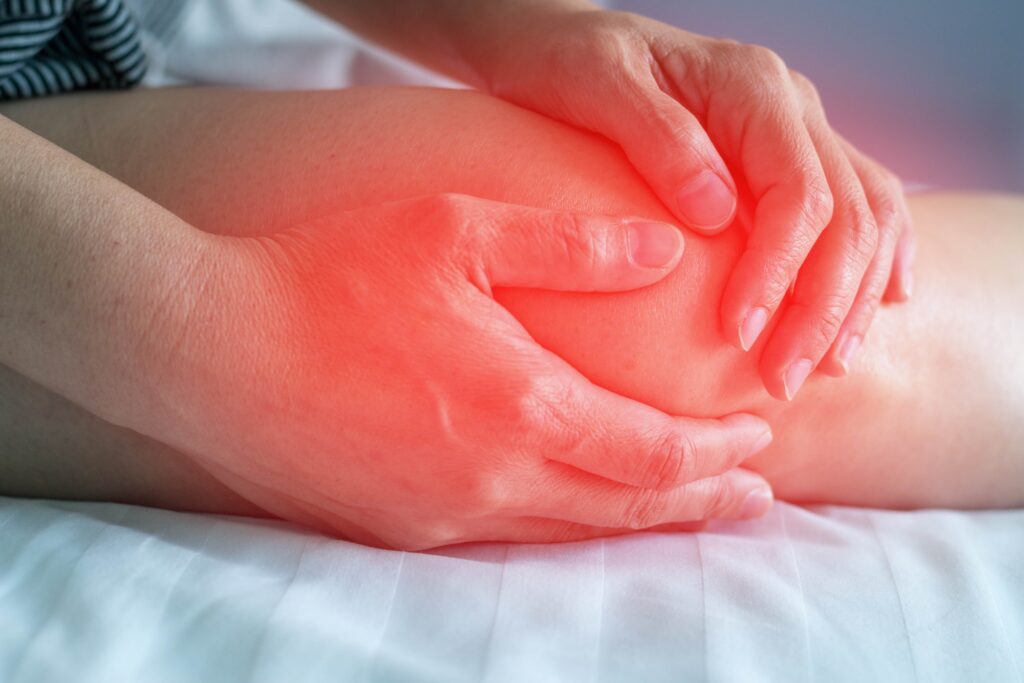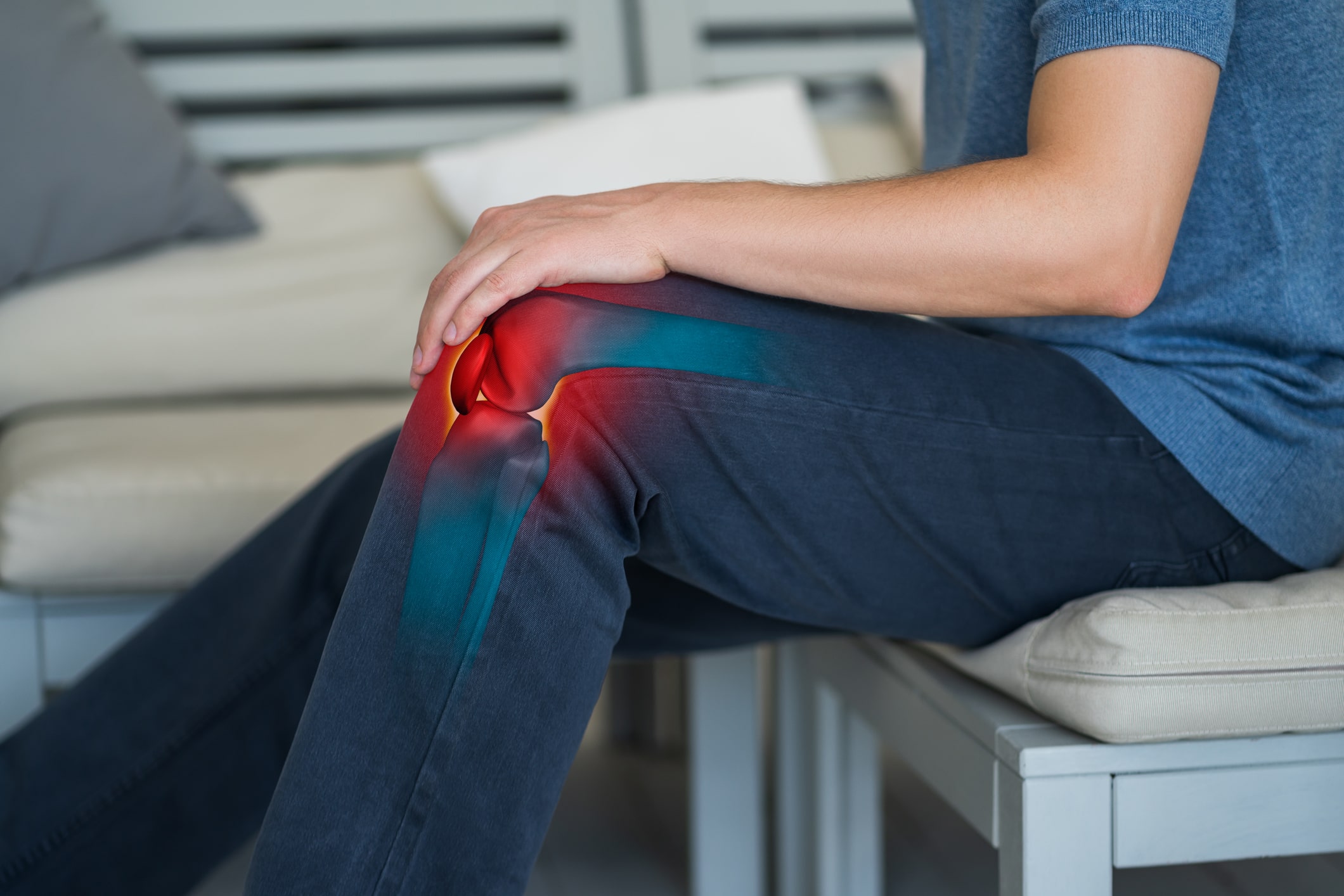Knee bursitis is a painful condition characterised by inflammation of one or more bursae, which are small fluid-filled sacs surrounding the knee joint.
These sacs serve as cushions or ‘shock absorbers’ to reduce friction between the bones and tendons during movement.
When the bursae become inflamed, it can cause discomfort and swelling, limiting joint motions and causing significant discomfort.
The condition is commonly associated with repetitive movements that exert pressure on the knee such as kneeling down on the knee. Occasionally it may be a cause of direct injury or due to conditions such as gout or Rheumatoid Arthritis
Symptoms of knee bursitis include a visible swelling over the knee, tenderness to the touch, and pain that may worsen with activity or prolonged periods of sitting or kneeling.
There are different types of knee bursitis, named after the specific bursa affected, such as prepatellar bursitis, which will be further discussed in this article.
Treatment for knee bursitis typically focuses on relieving pain and reducing inflammation. Initial self-care may include rest, ice, compression, and elevation (RICE), alongside the use of Nonsteroidal anti-inflammatory drugs (NSAIDs). In more severe cases, medical interventions, such as aspiration or corticosteroid injections, may be necessary. To prevent the condition from recurring, protective knee equipment may be recommended during activities, as well as exercises to strengthen the muscles around the knee joint.
Causes of Knee Bursitis
Knee bursitis is often the result of activities or inflame the bursae around the knee joint. Understanding the underlying causes can be key in preventing and managing this painful condition.
Prolonged pressure (when kneeling on the knee)
Sustained pressure on the knee, such as from prolonged kneeling or resting the knee on hard surfaces, can also cause knee bursitis. This is why it is prevalent in occupations such as carpet fitting and gardening. Interestingly it is also termed clergyman’s knee and housemaids knee because it was common in these two occupations!
Repetitive movements are another significant cause of knee bursitis. Activities that involve constant bending and extending of the knee can lead to overuse of the joint’s bursae.
For instance, runners and cyclists might experience knee bursitis due to the repetitive nature of knee motion.
Direct Impact Injury
A direct blow to the knee, such as a fall or a trauma during contact sports, can cause a direct injury leading to knee bursitis.
This can result in sudden swelling and pain in the bursae which can be very painful.
Types of Knee Bursitis
There are several types of knee bursitis, each affecting a different bursa within the knee area.
Prepatellar Bursitis
Prepatellar bursitis, often referred to as housemaid’s knee, occurs at the front of the knee. It is commonly caused by prolonged kneeling which increases pressure on the prepatellar bursa. Symptoms typically include redness and swelling over the kneecap. Often this swelling is also quite warm and can be mistaken for septic arthritis of the knee joint.
Infrapatellar Bursitis
Infrapatellar bursitis affects the bursa located just below the kneecap and above where the tendon from the shinbone attaches (patella tendon). There are two types of bursae located here, the superficial infrapatella bursa (sitting on top of the patella tendon) and deep infrapatella bursa (deep to the patell tendon).
Individuals may experience heat, swelling and tenderss at the lower part of the kneecap.
Activities that strain the knee joint like jumping or running can exacerbate the condition.
This condition can often be mistaken for Patella tendinopathy. In our experience a patient should have an ultrasound scan to give an accurate diagnosis.
Pes Anserine Bursitis
Pes anserine bursitis is the inflammation of the bursa located on the inner side of the knee, just below the joint. It is the bursa situated below the tendon which joins some of the muscles responsible for knee movement.
It can present as medial knee pain and is often associated with overuse from activities such as long-distance running or sports involving.
Sometimes a simple ‘knock’ on the knee can cause a flare of pes anserines bursitis.
It is also frequently seen in Osteoarthritis of the knee in Knee Valgus deformity or in patients with knock knees
Symptoms and Diagnosis
Recognising the symptoms of knee bursitis and obtaining an accurate diagnosis are crucial in managing the condition effectively.
Clinical Presentation
Knee bursitis typically presents with knee pain, tenderness, redness, warmth and swelling.
These symptoms often arise due to the inflammation of the bursae
How long does Knee Bursitis Last?
The duration of knee bursitis can vary. Generally, with appropriate treatment and management, knee bursitis should start to improve within a few weeks.
However the condition can sometimes be stubborn and some cases may take longer to heal. In cases where the cause is still there, the condition can become chronic.
Diagnostic Tests
Diagnosing knee bursitis involves a combination of clinical examination and medical imaging.
The clinician will assess the knee’s range of motion and check for swelling, tenderness, and warmth.
Scans such as ultrasound are diagnostic and relatively cheap and quick
MRI scans are also useful when other causes of knee swelling are being sought.
Occasionally when a patient presents to the uregent care centre and the swelling is substantial with limitation in knee movement, the doctor may take blood tests to rule out a bacterial infection
Treatment Options
When treating knee bursitis, Selection of treatment depends on the severity of inflammation and the presence of infection.
Injections
For persistent bursitis, doctors may recommend Cortisone injections to reduce inflammation and provide pain relief. This procedure is often performed under ultrasound guidance to ensure accuracy and efficacy.
Conservative Management
Rest and ICE applied to the area are initial steps in managing knee bursitis. Activity modification and the use of protective knee pads may prevent further irritation
Medications
Over-the-counter non-steroidal anti-inflammatory drugs (NSAIDs) like ibuprofen can help with the pain and inflammation. For bacterial infections, a course of oral antibiotics may be necessary. Antibiotics should only be started after confirmed infection followig a blood test
Surgical Procedures
Surgery for knee bursitis is generally considered when other treatments have failed or the patient keeps getting severe flare ups despite repeated Cortisone injections. This might include bursa removal (Bursectomy)
Prevention Strategies
There are several things one can do to reduce the chances of getting knee bursitis.
- Gradual Activity Increase: When starting a new physical activity, one should increase the intensity and duration gradually to avoid too much stress on the knee joint.
- Proper Warm-up: Beginning any physical activity with knee stretches and a proper warm-up routine is essential to prepare the muscles and joints, which helps to lower the chance of injury.
- Protective Gear: Usinhg appropriate knee padding can help protect against impact and pressures that can cause bursitis, especially for individuals whose activities or occupations are a risk factor and involve pressure on the knee bursa.
Rehabilitation and Recovery
Recovering from knee bursitis generally involves steps aimed at reducing inflammation and pain while maintaining joint function.
A good way to rehab is to include rest, ice, and, if necessary, anti-inflammatory medications.
Initial Phase:
- Rest: Avoid activities that exacerbate symptoms.
- Ice: Apply cold compresses to the knee to reduce swelling.
Gentle range-of-motion exercises to prevent stiffness. As symptoms improve, strengthening exercises targeting the knee muscles support long-term recovery.
- Range of motion: Gentle exercises to maintain joint mobility.
- Strengthening: Gradual intensity increase to rebuild muscle support.
Frequently Asked Questions
What are the typical signs and symptoms of bursitis in the knee?
Individuals with knee bursitis typically experience pain in the affected joint around the knee cap region, which may also be tender, warm, and swollen. These symptoms can intefere with knee mobility and walking
How can one effectively treat bursitis of the knee at home?
At-home treatment for knee bursitis includes rest, ice application to reduce swelling, and gentle compression with a wrap or knee sleeve.
How long is the recovery period for knee bursitis?
The recovery time for knee bursitis varies but typically spans a few weeks. The general improvement in knee bursitis is 2-8 weeks
What are the primary causes of knee bursitis?
Knee bursitis is typically caused by direct pressure/friction over the knee bursae, leading to inflammation of the bursae. Repetitive movement, impact or injuries can also be contributing factors.
Is it advisable to continue walking when diagnosed with knee bursitis?
Individuals with knee bursitis should avoid too much walking when having a flare up. They should limit the intensity and frequency to prevent worsening of the symptoms.
Is Treatment for Knee Bursitis available in Manchester?
Yes! MyMSK Clinic offer a consultation, which involves ultrasound scanning the affected area, in Deansgate, Manchester.
To arrange a consultation please visit our Booking Page or call us on 0333 772 9655.






